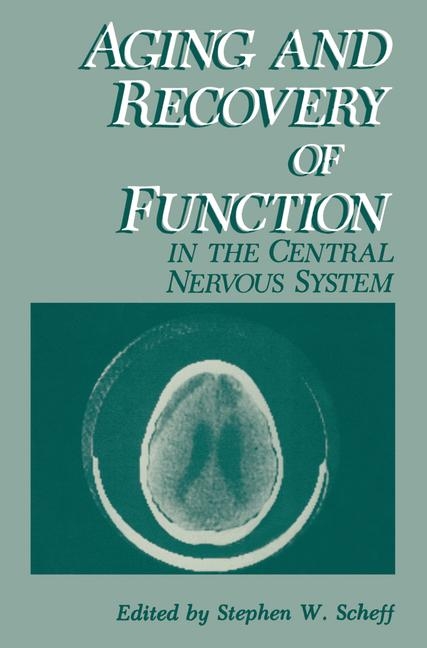
Aging and Recovery of Function in the Central Nervous System
Kluwer Academic/Plenum Publishers (Verlag)
978-0-306-41525-8 (ISBN)
- Titel ist leider vergriffen;
keine Neuauflage - Artikel merken
1 Longevity, Disease, and Autoimmune Reactions following Focal Cortical Injuries.- 1. Introduction.- 2. Longevity.- 3. Disease Profiles.- 4. Neuron-Binding Antibodies.- 5. Conclusions.- References.- 2 Aging and Hypothalamic Regulation of Metabolic, Autonomic, and Endocrine Function.- 1. Introduction.- 1.1. Theories of Aging.- 1.2. Aging-Related Changes in Behavioral and Physiological Function.- 2. Structure and Function of the Hypothalamus.- 3. Hypothalamic Theories of Aging.- 3.1. Dilman’s Hypothalamic Elevation Theory.- 3.2. Groen’s Hypothalamic Theory.- 3.3. Frolkis’s Hypothalamic Disregulation Theory.- 4. Effects of Hypothalamic Damage.- 4.1. Lateral Hypothalamic Damage.- 4.2. Ventromedial Hypothalamic Damage.- 5. Aging-Hypothalamic Damage Comparisons.- 6. Overview and Summary.- References.- 3 Morphological Measurements in the Aging Rat Cerebral Cortex.- 1. Introduction.- 2. Neuronal and Glial Cell Number Changes during Aging.- 2.1. Dendritic Branching.- 2.2. Dendritic Density.- 2.3. Dendritic Length.- 2.4. Dendritic Spines.- 3. Aging and Impoverishment.- 3.1. Dendrites.- 3.2. Oblique Branching.- 3.3. Oblique Length.- 3.4. Spines.- 4. Summary.- References.- 4 Morphologic Aspects of Brain Damage in Aging.- 1. Introduction.- 2. Reactive Synaptogenesis in Young Adult Animals.- 3. Normal Anatomy of the Aged Hippocampus.- 3.1. Light Microscopic Analysis.- 3.2. Electron Microscopic Analysis.- 4. Reactive Synaptogenesis in the Dentate Gyrus of Aged Animals.- 4.1. Light Microscopic Analysis.- 4.2. Ultrastructural Analysis.- 5. Adrenergic Sprouting in the Limbic System of Aged Rats.- 6. Possible Mechanisms for Reduced Sprouting Capacity.- 7. Conclusion.- References.- 5 Relationship of the Raphe and Suprachiasmatic Nuclei to Serotonin Facilitation of Cyclic Reproductive Functions in Aging Female Rats.- 1. Introduction.- 2. Temporal Patterns of Hypothalamic 5-HT and Cyclic Reproductive Function.- References.- 6 Behavioral Consequences of Neuronal Plasticity following Injury to Nigrostriatal Dopaminergic Neurons.- 1. Introduction.- 2. Approaches to Studying the Neural Events Mediating Behavioral Recovery.- 3. Inattention to Stimuli.- 4. Neglect after Nigrostriatal Injury as a Model System.- 5. Neural Events Contributing to Recovery of Sensorimotor Functions.- 5.1. Basal Gangliar Glucose Utilization.- 5.2. Compensatory Changes at Residual Neostriatal Dopaminergic Synapses and Recovery.- 5.3. Recovery from Nigrostriatal Injury in Senescence.- 5.4. Lithium Effects on Recovery.- 6. Future Directions.- 7. Conclusions.- References.- 7 Do Rats Have Hypotheses? A Developmental and Means-Ends Analyses Approach to Brain Damage, Recovery of Function, and Aging.- 1. Introduction.- 2. Methods.- 2.1. Subjects and Surgery.- 2.2. Behavioral Testing.- 2.3. Histology.- 2.4. Data Analysis.- 3. Results.- 3.1. Qualitative Results.- 3.2. Medial Frontal Lesion Analysis.- 4. Discussion.- References.- 8 Age, Brain Damage, and Behavioral Recovery.- 1. Introduction.- 2. Spatial Alternation Learning.- 2.1. General Methodology.- 2.2. Single-Stage Lesion Effects.- 2.3. Serial Lesion Effect.- 3. Emotional Reactivity.- 4. DRL-20 Performance.- 5. Discussion.- References.- 9 Age and Recovery from Brain Damage: A Review of Clinical Studies.- 1. Functional Plasticity after Early Brain Injury.- 1.1. Implications of Ablation Experiments for Recovery in Children: Methodological Issues in Recovery from Brain Injury at Different Ages.- 1.2. Perinatal and Neonatal Injury.- 1.3. Early Lateralized Brain Injury.- 1.4. Diffuse Insult to the Young Brain.- 2. Head Injury through the Lifespan.- 2.1. Incidence.- 2.2. Cause of Head Injury.- 2.3. Risk Factors.- 3. Pathophysiology of Closed-Head Injury in Relation to Age.- 4. Effects of Age on Outcome after Head Injury.- 5. Early and Late Neurobehavioral Effects of Head Injury.- 5.1. Subacute Behavioral Effects after Head Injury in Children.- 5.2. Residual Neuropsychological Sequelae.- 5.3. Residual Behavioral Disturbance after Head Injury in Children.- 5.4. Summary of Research on Recovery after Head Injury.- 6. Directions for Future Research.- References.- 10 Recovery of Function in Senile Dementia of the Alzheimer Type.- 1. Introduction.- 2. Alzheimer’s Disease: The Clinical and Biochemical Problem.- 3. Behavioral Strategies for Cognitive Deficits of Alzheimer’s Disease.- 4. Pharmacologic Intervention in Alzheimer’s Disease.- 5. Cholinergic Systems, Trophic Substances, and Potential Therapies for Alzheimer’s Disease.- 6. Pharmacologic Enhancement of a Trophic Factor Effect.- References.
| Erscheint lt. Verlag | 1.4.1984 |
|---|---|
| Zusatzinfo | 41 Illustrations, black and white; XIV, 222 p. 41 illus. |
| Verlagsort | New York |
| Sprache | englisch |
| Gewicht | 468 g |
| Themenwelt | Medizin / Pharmazie ► Medizinische Fachgebiete ► Geriatrie |
| Naturwissenschaften ► Biologie ► Humanbiologie | |
| Naturwissenschaften ► Biologie ► Zoologie | |
| ISBN-10 | 0-306-41525-9 / 0306415259 |
| ISBN-13 | 978-0-306-41525-8 / 9780306415258 |
| Zustand | Neuware |
| Haben Sie eine Frage zum Produkt? |
aus dem Bereich


